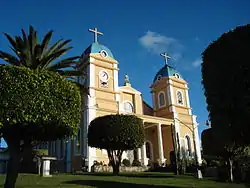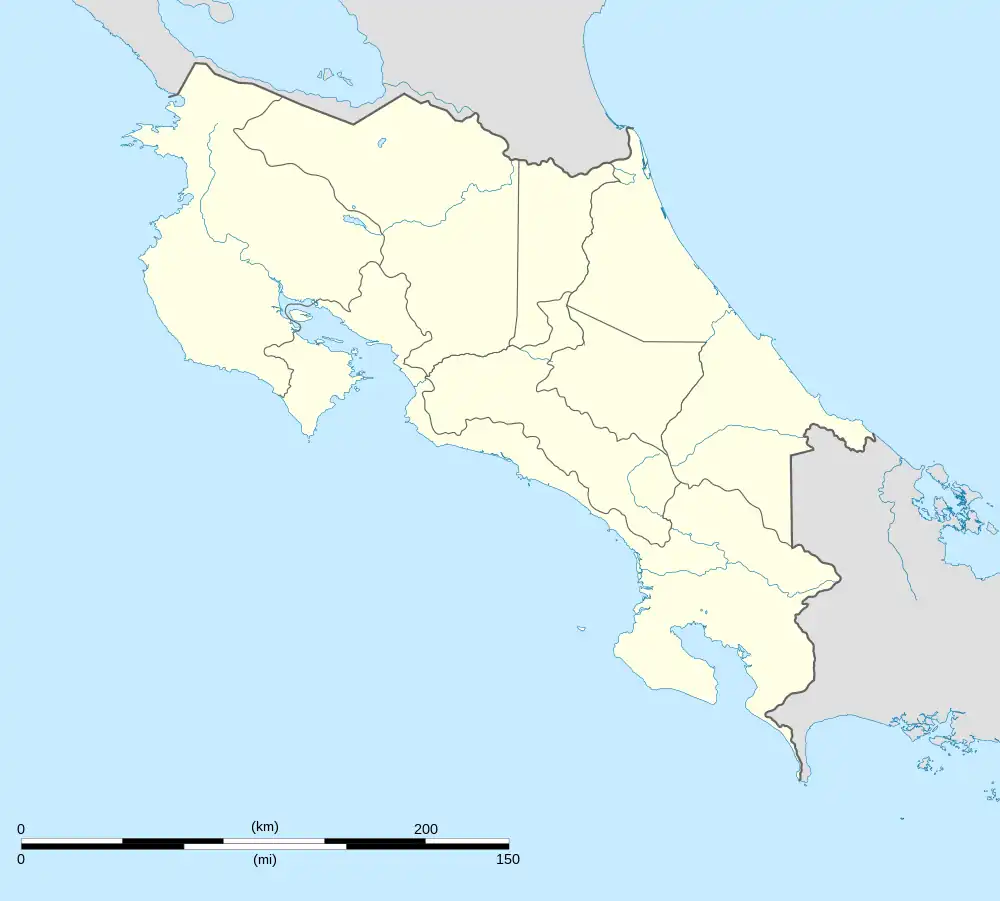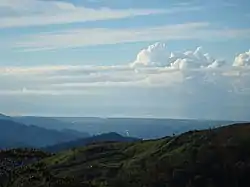San Marcos, Costa Rica
San Marcos is a district and the head city of the canton of Tarrazú in the province of San José in Costa Rica. [1][2]
San Marcos | |
|---|---|
 San Marcos de Tarrazu Roman Catholic church, Costa Rica | |
San Marcos district | |
 San Marcos San Marcos district location in Costa Rica | |
| Coordinates: 9.6703061°N 84.0091815°W | |
| Country | |
| Province | San José |
| Canton | Tarrazú |
| Creation | 3 August 1938 |
| Area | |
| • Total | 45.53 km2 (17.58 sq mi) |
| Elevation | 1,429 m (4,688 ft) |
| Population (2011) | |
| • Total | 9,993 |
| • Density | 220/km2 (570/sq mi) |
| Time zone | UTC−06:00 |
| Postal code | 10501 |
History
The city was founded in the 1820s by agricultural migrants from the Central Valley. The region's earliest residents were dedicated to growing basic foodstuffs, namely beans, corn, and sugar cane. Local farmers started growing coffee in the highland valley in the 1890s. The region is best known for its high quality coffee.[3]
Geography
San Marcos has an area of 45.53 km²[4] and a mean elevation of 1,429 metres.[1]
It is located in a mountainous area known as Los Santos Zone, 70 kilometers south of the national capital city of San José.
San Marcos de Tarrazu is located in the north bank of the Pirris River, in a highland valley surrounded by mountains that are part of the Talamanca Sierra in southern Costa Rica. Downtown San Marcos is 1350 meters above sea level but is surrounded by peaks as high as 3000 meters above sea level.
Its geography is suited to growing coffee, mostly because the slopes of the mountains face the morning light and the cloud cover protects the coffee trees in the afternoon. The red soil found in the valley is of volcanic origin. All this plus the altitude make ideal conditions to grow the coffees harvested by locals.
 Downtown San Marcos de Tarrazu - Catholic Church in the background
Downtown San Marcos de Tarrazu - Catholic Church in the background Concepcion de Tarrazu highlands near Quepos Port, Costa Rica
Concepcion de Tarrazu highlands near Quepos Port, Costa Rica Naranjillo de Tarrazu, as seen from Concepcion, near Port Quepos
Naranjillo de Tarrazu, as seen from Concepcion, near Port Quepos Coffee fields Quebrada Honda de Tarrazu
Coffee fields Quebrada Honda de Tarrazu Downtown San Marcos de Tarrazu National bank branch to the left and the popular "Bar El Banco" to the right, in a busy December afternoon
Downtown San Marcos de Tarrazu National bank branch to the left and the popular "Bar El Banco" to the right, in a busy December afternoon
Politics
This region has a deep-seated political relationship with the Liberación Nacional political party that stems back to the 1948 Civil War. Jose "Pepe" Figueres and his troops were not only headquartered in the neighboring community of Santa Maria de Dota, but the main concentration camp of political prisoners for these forces was housed in San Marcos' school. Moreover, a vast majority of Figueres' foot soldiers were from the present-day cantons of Tarrazu, Dota, and Leon Cortes. Furthermore, most of Figueres' workers at his cabuya hacienda, "La Lucha Sin Fin," were from this same region. [5]
Economy
Traditionally, cultural and economic progress have been directly tied to the coffee industry. More recently, however, other agricultural products, namely avocados, have helped farmers keep afloat in years of coffee decline. Perhaps the key reason this region has managed to retain its coffee production, while other regions in Costa Rica have been unable to do so has been immigration. Indeed, since the 1960s this region has exported a considerable percentage of its workforce to the United States.
Transportation
Road transportation
The district is covered by the following road routes:
Flora and fauna
The district of San Lorenzo has been almost overlooked by coffee farmers mostly because of its lowlands and tropical weather. However, more recently tourism has flourished thanks to its pristine forests and clean rivers, the proximity to the Quepos plains and Manuel Antonio National Park. Giant pre-historic ferns and hardwoods can be found here. Birds such as the Quetzal and small mammals are abundant.
Demographics
| Historical population | |||
|---|---|---|---|
| Census | Pop. | %± | |
| 1883 | 552 | — | |
| 1892 | 815 | 47.6% | |
| 1927 | 1,639 | 101.1% | |
| 1950 | 1,900 | 15.9% | |
| 1963 | 2,546 | 34.0% | |
| 1973 | 3,838 | 50.7% | |
| 1984 | 5,381 | 40.2% | |
| 2000 | 8,240 | 53.1% | |
| 2011 | 9,993 | 21.3% | |
|
Instituto Nacional de Estadística y Censos[6] |
|||
For the 2011 census, San Marcos had a population of 9,993 inhabitants. [8] The majority of its people grow coffee in the mountains surrounding the city. San Marcos de Tarrazú has been known in the green coffee trade industry as a source of coffee beans. Nearby towns of Santa Maria and San Pablo are also sources of specialty coffee beans. Roman Catholics comprise approx. 90% of the local population. Due to coffee picking, Nicaraguans and Panamanian native americans are settling in the valley in record numbers.
Culture
Local culture varies little from that of the rest of Costa Rica, in that the Catholic Church and the Costa Rican state both play a critical role in determining days of celebration. Indeed, the annual Patron Saints' Day Festival is both a civic and a religious event. Whereas much of Costa Rica has allowed the cultural importance of coffee production to decline, this region is deeply wedded to this crops' production. This is evident in the fact that a majority of the region's children continue to pick coffee, a custom that has largely gone out of fashion in the Central Valley where coffee picking is almost entirely done by foreign laborers, namely Nicaraguans. The region has a number of bars, dance halls, and brothels but few other spaces for leisure activity.
Notable people
- Maria Eugenia Bozzoli (born 1935), anthropologist
References
- "Declara oficial para efectos administrativos, la aprobación de la División Territorial Administrativa de la República N°41548-MGP". Sistema Costarricense de Información Jurídica (in Spanish). 19 March 2019. Retrieved 26 September 2020.
- División Territorial Administrativa de la República de Costa Rica (PDF) (in Spanish). Editorial Digital de la Imprenta Nacional. 8 March 2017. ISBN 978-9977-58-477-5.
- Kordick, Carmen. The Saints of Progress: Coffee, Migration, and Costa Rican National Identity. University of Alabama Press, 2019.
- "Área en kilómetros cuadrados, según provincia, cantón y distrito administrativo". Instituto Nacional de Estadística y Censos (in Spanish). Retrieved 26 September 2020.
- Kordick, Carmen. The Saints of Progress: Coffee, Migration, and Costa Rican National Identity. University of Alabama Press, 2019.
- "Instituto Nacional de Estadística y Censos" (in Spanish).
- "Sistema de Consulta de a Bases de Datos Estadísticas". Centro Centroamericano de Población (in Spanish).
- "Censo. 2011. Población total por zona y sexo, según provincia, cantón y distrito". Instituto Nacional de Estadística y Censos (in Spanish). Retrieved 26 September 2020.